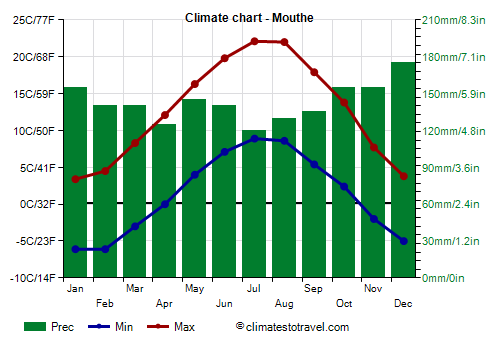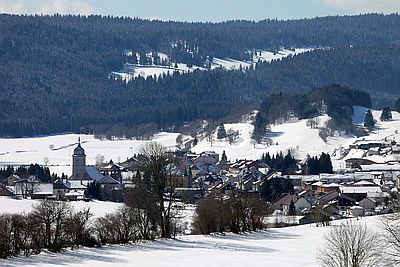Select units of measurement for the temperature and rainfall tables (metric or imperial).
Average weather, temperature, rainfall, sunshine hours

The climate of Mouthe is
moderately continental, characterized by cold winters, with temperatures often below freezing (0 °C or 32 °F), and mild or pleasantly warm summers.
The city is located in the east of France, at the foot of the Jura massif, the mountain range that separates France and Switzerland, at 950 meters (3,200 feet) above sea level, in the Burgundy-Franche-Comté region, and in the Doubs department.
Precipitation is abundant and well distributed throughout the year, which means that there can be abundant snowfalls in winter, while rains and thunderstorms are quite frequent in summer.
The valley where Mouthe is located is known as the
"little Siberia", in fact the cold record of France has been set here: as low as -36.7 °C (-34 °F), recorded in 1968 (according to some sources, the temperature reached -41 °C or -42 °F in January 1985, but the data is doubtful). And in any case, during the winter, temperatures around -20 °C (-4 °F) are not unusual.
These exceptional temperatures occur only under certain conditions: during polar cold waves, cold air settles in the valley creating conditions of
thermal inversion. The position in a wide valley with few trees favors the stagnation of the air and the loss of heat during the night by radiation. Snow on the ground produces additional cooling.
When these extreme temperatures are recorded, a very strong thermal inversion is created. For example, in La Brévine, a town located in the same area but in Switzerland, in January 1985, when the temperature was -41 °C, at a height of 100 meters (330 feet) above the ground, the temperature was -20,5 °C (-5 °F)!
Since the cold layer is very thin, it dissolves rapidly during the day, and the temperature increases by many degrees, and can reach around freezing.
On average, the night temperature drops below freezing for one day out of two, and sometimes it can drop slightly below freezing even in summer. This suggests that the general conditions favor a strong night cooling even in the absence of snow on the ground.

In
summer, temperatures are pleasant and suitable for outdoor activities, although sometimes there can be rains and thunderstorms, and it can get very cool at night due to altitude.
Occasionally (but less than in the lowlands), there may be brief hot periods, which in recent years are becoming more frequent due to global warming. The highest record is 36 °C (96.8 °F) and was set in July 1952.
Best Time
The
best time to visit Mouthe runs from June to August, since it is the mildest and sunniest period of the year. Sometimes, nights can be cool or even cold even in these months, so it can be useful to bring a sweatshirt or sweater and a jacket for the evening.
Mouthe - Climate data
In Mouthe, the
average temperature of the coldest month (January) is of
-1.3 °C, that of the warmest month (July) is of
15.5 °C. Here are the average temperatures.
Mouthe - Average temperatures (1991-2020) |
| Month | Min | Max | Mean |
|---|
| January | -6.1 | 3.4 | -1.3 |
|---|
| February | -6.1 | 4.5 | -0.8 |
|---|
| March | -3 | 8.3 | 2.7 |
|---|
| April | 0 | 12.1 | 6 |
|---|
| May | 4 | 16.3 | 10.2 |
|---|
| June | 7.1 | 19.8 | 13.4 |
|---|
| July | 8.9 | 22.1 | 15.5 |
|---|
| August | 8.6 | 22 | 15.3 |
|---|
| September | 5.4 | 17.9 | 11.6 |
|---|
| October | 2.4 | 13.8 | 8.1 |
|---|
| November | -2 | 7.7 | 2.8 |
|---|
| December | -5 | 3.8 | -0.6 |
|---|
| Year | 1.2 | 12.7 | 6.95 |
|---|
amounts to
1715 millimeters per year: it is therefore abundant. It ranges from
120 millimeters in the driest month (July) to
175 millimeters in the wettest one (December). Here is the average precipitation.
Mouthe - Average precipitation| Month | Days |
|---|
| January | 155 | 14 |
|---|
| February | 140 | 13 |
|---|
| March | 140 | 13 |
|---|
| April | 125 | 13 |
|---|
| May | 145 | 15 |
|---|
| June | 140 | 12 |
|---|
| July | 120 | 11 |
|---|
| August | 130 | 12 |
|---|
| September | 135 | 10 |
|---|
| October | 155 | 13 |
|---|
| November | 155 | 13 |
|---|
| December | 175 | 14 |
|---|
| Year | 1715 | 152 |
|---|
Mouthe - Weather by month
Based on the period 1991-2020
January, the coldest month of the year, is generally a very cold month. The average temperature is of
-1.3 °C, with a minimum of
-6.1 °C and a maximum of
3.4 °C.

On the coldest nights of the month, the temperature usually drops to around
-18 °C. However, it dropped to
-27 °C in January 2016.

On the warmest days of the month, the temperature usually reaches around
10.5 °C. However, it reached
19 °C in January 2002.

Precipitation amounts to
155 mm, distributed over 14 days.
The day lasts on average 9 hours and 5 minutes.
February is generally a very cold month. The average temperature is of
-0.8 °C, with a minimum of
-6.1 °C and a maximum of
4.5 °C.

On the coldest nights of the month, the temperature usually drops to around
-18 °C. However, it dropped to
-28 °C in February 1999.

On the warmest days of the month, the temperature usually reaches around
13 °C. However, it reached
18.5 °C in February 2002.

Precipitation amounts to
140 mm, distributed over 13 days.
The day lasts on average 10 hours and 25 minutes.
March is generally a cold month. The average temperature is of
2.7 °C, with a minimum of
-3 °C and a maximum of
8.3 °C.

On the coldest nights of the month, the temperature usually drops to around
-12.5 °C. However, it dropped to
-25 °C in March 2005.

On the warmest days of the month, the temperature usually reaches around
17.5 °C. However, it reached
22 °C in March 1994.

Precipitation amounts to
140 mm, distributed over 13 days.
The day lasts on average 12 hours and 0 minutes.
April is generally a quite cold month. The average temperature is of
6 °C, with a minimum of
0 °C and a maximum of
12.1 °C.

On the coldest nights of the month, the temperature usually drops to around
-6.5 °C. However, it dropped to
-12.5 °C in April 1991.

On the warmest days of the month, the temperature usually reaches around
20.5 °C. However, it reached
23.9 °C in April 2005.

Precipitation amounts to
125 mm, distributed over 13 days.
The day lasts on average 13 hours and 35 minutes.
May is generally a mild month. The average temperature is of
10.2 °C, with a minimum of
4 °C and a maximum of
16.3 °C.

On the coldest nights of the month, the temperature usually drops to around
-2.5 °C. However, it dropped to
-5 °C in May 1995.

On the warmest days of the month, the temperature usually reaches around
25 °C. However, it reached
29.6 °C in May 2009.

Precipitation amounts to
145 mm, distributed over 15 days.
The day lasts on average 15 hours and 5 minutes. So the days are long.
June is generally a mild month. The average temperature is of
13.4 °C, with a minimum of
7.1 °C and a maximum of
19.8 °C.

On the coldest nights of the month, the temperature usually drops to around
0.5 °C. However, it dropped to
-2 °C in June 1998.

On the warmest days of the month, the temperature usually reaches around
28.5 °C. However, it reached
33.5 °C in June 2002.

Precipitation amounts to
140 mm, distributed over 12 days.
The day lasts on average 15 hours and 50 minutes. So the days are long. June 21, the summer solstice, is the longest day of the year in the Northern Hemisphere.
July, the warmest month of the year, is generally a very mild month. However, there are remarkable differences between night and day. The average temperature is of
15.5 °C, with a minimum of
8.9 °C and a maximum of
22.1 °C.

On the coldest nights of the month, the temperature usually drops to around
2 °C. However, it dropped to
-0.5 °C in July 2011.

On the warmest days of the month, the temperature usually reaches around
30 °C. However, it reached
34 °C in July 2015.

Precipitation amounts to
120 mm, distributed over 11 days.
The day lasts on average 15 hours and 25 minutes. So the days are long.
August is generally a very mild month. However, there are remarkable differences between night and day. The average temperature is of
15.3 °C, with a minimum of
8.6 °C and a maximum of
22 °C.

On the coldest nights of the month, the temperature usually drops to around
2 °C. However, it dropped to
-1.2 °C in August 2009.

On the warmest days of the month, the temperature usually reaches around
29.5 °C. However, it reached
34.1 °C in August 2012.

Precipitation amounts to
130 mm, distributed over 12 days.
The day lasts on average 14 hours and 5 minutes. So the days are long.
September is generally a mild month. The average temperature is of
11.6 °C, with a minimum of
5.4 °C and a maximum of
17.9 °C.

On the coldest nights of the month, the temperature usually drops to around
-1 °C. However, it dropped to
-4 °C in September 1995.

On the warmest days of the month, the temperature usually reaches around
25.5 °C. However, it reached
28.4 °C in September 2020.

Precipitation amounts to
135 mm, distributed over 10 days.
The day lasts on average 12 hours and 30 minutes.
October is generally a quite mild month. The average temperature is of
8.1 °C, with a minimum of
2.4 °C and a maximum of
13.8 °C.

On the coldest nights of the month, the temperature usually drops to around
-5.5 °C. However, it dropped to
-14 °C in October 2003.

On the warmest days of the month, the temperature usually reaches around
22 °C. However, it reached
26.8 °C in October 2009.

Precipitation amounts to
155 mm, distributed over 13 days.
The day lasts on average 10 hours and 50 minutes.
November is generally a cold month. The average temperature is of
2.8 °C, with a minimum of
-2 °C and a maximum of
7.7 °C.

On the coldest nights of the month, the temperature usually drops to around
-11.5 °C. However, it dropped to
-22 °C in November 2010.

On the warmest days of the month, the temperature usually reaches around
16.5 °C. However, it reached
21 °C in November 1995.

Precipitation amounts to
155 mm, distributed over 13 days.
The day lasts on average 9 hours and 25 minutes.
December is generally a very cold month. The average temperature is of
-0.6 °C, with a minimum of
-5 °C and a maximum of
3.8 °C.

On the coldest nights of the month, the temperature usually drops to around
-16 °C. However, it dropped to
-26.9 °C in December 2005.

On the warmest days of the month, the temperature usually reaches around
11 °C. However, it reached
15.3 °C in December 2012.

Precipitation amounts to
175 mm, distributed over 14 days.
The day lasts on average 8 hours and 35 minutes. December 21, the winter solstice, is the shortest day of the year in the Northern Hemisphere.